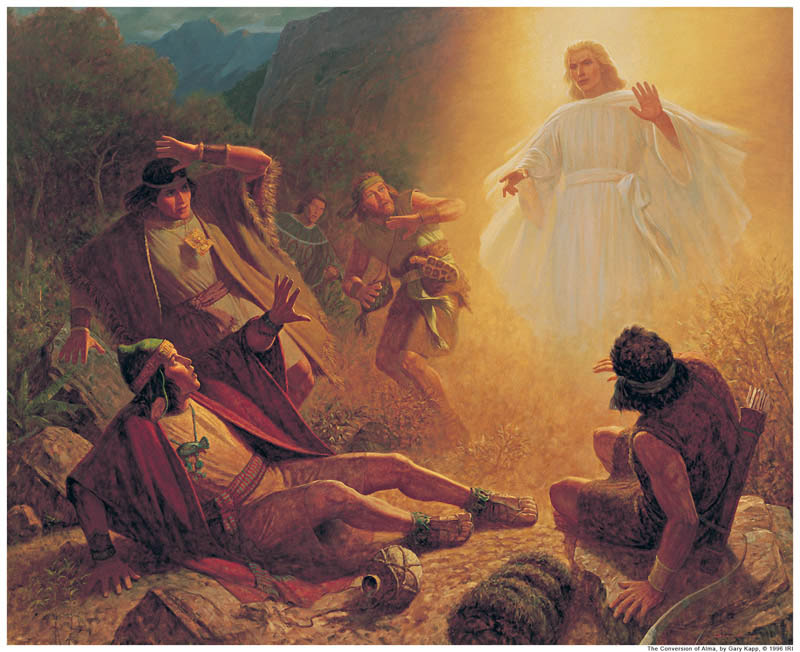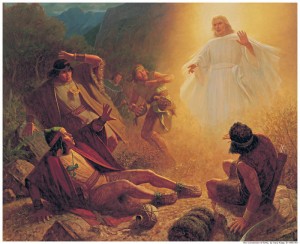Alma the younger and Paul the Apostle have much in common: they both persecuted the followers of God, and ways by a heavenly visitation, and both yielded to their revelation of Light by humbly receiving the call to serve. Paul and Alma are the most prolific contributors to the New Testament and the Book of Mormon, respectively.
Here’s how the Book of Mormon describes the wicked ways of Alma before his conversion:
“Now the sons of Mosiah were numbered among the unbelievers; and also one of the sons of Alma was numbered among them, he being called Alma, after his father; nevertheless, he became a very wicked and an idolatrous man. And he was a man of many words, and did speak much flattery to the people; therefore he led many of the people to do after the manner of his iniquities. And he became a great hinderment to the prosperity of the church of God; stealing away the hearts of the people; causing much dissension among the people” (Mosiah 27: 8, 9).
And then, as it was with Saul who became Paul, Alma was confronted with a call from Heaven, the call to serve:
“For I went about with the sons of Mosiah, seeking to destroy the church of God; but behold, God sent his holy angel to stop us by the way. And behold, he spake unto us, as it were the voice of thunder, and the whole earth did tremble beneath our feet; and we all fell to the earth, for the fear of the Lord came upon us. But behold, the voice said unto me: Arise. And I arose and stood up, and beheld the angel. And he said unto me: If thou wilt of thyself be destroyed, seek no more to destroy the church of God. And it came to pass that I fell to the earth; and it was for the space of three days and three nights that I could not open my mouth, neither had I the use of my limbs” (Alma 36: 6-10).
Paul’s heavenly revelation caused him to lose his sight for three days (Acts 9: 9), and in Alma’s angelic visitation, he was struck dumb and lost the use of his limbs. This miraculous conversion account of Alma the younger is either a fact or a fable, and as one personally discerns what is real from what is rhetoric, consider this additional information:
The account of Alma’s conversion as contained in the Book of Mormon, is written in a literary style common to the Hebrew culture called chiasmus. This poetic form begins by expressing a set of ideas in order ( a, b, c ) and then the message is reinforced with a parallel reiteration in reverse order ( c, b, a ). A set of three ideas is just an example, the elements of chiasmus could be expressed in a parallel set as small as two, or in larger sets of any number. The most important message is typically found in the middle of the ascending and descending parallel sets.
The word chiasmus (pronounced ki-az’-mus) derives from the Greek letter chi (X) which symbolizes the top-to-bottom mirror reflection achieved in the repeating poetic form. Examples of chiasmus are found in the Bible (Matt. 19: 30; Psalms 124:7; Isaiah 6:10).
Now to a fact that is impossible to explain away using reasonable reason and evidence-based logic.
The Book of Mormon was first published in 1830. It was brought forth by its translator, Joseph Smith. So, how is it that the Book of Mormon contains so many rich examples of the Hebrew literary form of chiasmus, when academic scholars have only been aware of, and have written about, this form within the last century? How could an unschooled boy living in the early 1800’s even know about chiasmus, much less replicate this style of writing? Yet the Book of Mormon contains many clear and elaborate examples of chiasmus.
Why would a Hebrew style of writing appear in the Book of Mormon in the first place? Because it is written by Hebrews–descendants of Joseph, the son of Israel. The Book of Mormon is “the stick of Joseph” of which Ezekial prophesied (Ezek. 37: 15-19).
The conversion story of Alma the younger is recorded in the 36th chapter of Alma in the Book of Mormon; this entire chapter is written in the poetic pattern of Chiamus. Here is an outline of Alma’s conversion; capitalized words indicate the repeating parallels:
a – My son, give ear to my WORDS (v. 1)
b – KEEP THE COMMANDMENTS and ye shall PROSPER IN THE LAND (v. 2)
c – DO AS I HAVE DONE (v. 2)
d – in REMEMBERING THE CAPTIVITY of our fathers (v. 2);
e – for they were in BONDAGE (v. 2)
f – he surely did DELIVER them (v. 2)
g – TRUST in God (v. 3)
h – supported in their TRIALS, and TROUBLES, and AFFLICTIONS (v. 3)
i – shall be LIFTED UP at the LAST DAY (v. 3)
j – I KNOW this NOT OF MYSELF but of GOD (v. 4)
k – BORN OF GOD (v. 5)
l – I SOUGHT to destroy the church of God (v. 6-9)
m – MY LIMBS were paralyzed (v. 10)
n – Fear of being in the PRESENCE OF GOD (v. 14-15)
o – PAINS of a damned soul (v. 16)
p – HARROWED UP BY THE MEMORY OF SINS (v. 17)
q – I remembered JESUS CHRIST, SON OF GOD (v. 17)
q – I cried, JESUS, SON OF GOD (v. 18)
p – HARROWED UP BY THE MEMORY OF SINS no more (v. 19)
o – Joy as exceeding as was the PAIN (v. 20)
n – Long to be in the PRESENCE OF GOD (v. 22)
m – My LIMBS received their strength again (v. 23)
l – I LABORED to bring souls to repentance (v. 24)
k – BORN OF GOD (v. 26)
j – Therefore MY KNOWLEDGE IS OF GOD (v. 26)
h – Supported under TRIALS, TROUBLES, and AFFLICTIONS (v. 27)
g – TRUST in him (v. 27)
f – He will DELIVER me (v. 27)
i – and RAISE ME UP at the LAST DAY (v. 28)
e – As God brought our fathers out of BONDAGE and captivity (v. 28-29)
d – Retain in REMEMBRANCE THEIR CAPTIVITY (v. 28-29)
c – KNOW AS I DO KNOW (v. 30)
b – KEEP THE COMMANDMENTS and ye shall PROSPER IN THE LAND (v. 30)
a – This is according to his WORD (v. 30)
The central message of Alma’s conversion account testifies of Jesus Christ and His redeeming atonement (Alma 36: 16-20). As the literary style of Chiasmus is studied thoroughly and carefully, the fact that Alma wrote his story of conversion using chiasmus is as compelling as a fireball from heaven or a heavenly visitation; yet, neither compelling logic nor spectacular manifestations will convince the hearts of those who will not hear and heed the continuous call of the “still small voice”–as did Alma the younger.



